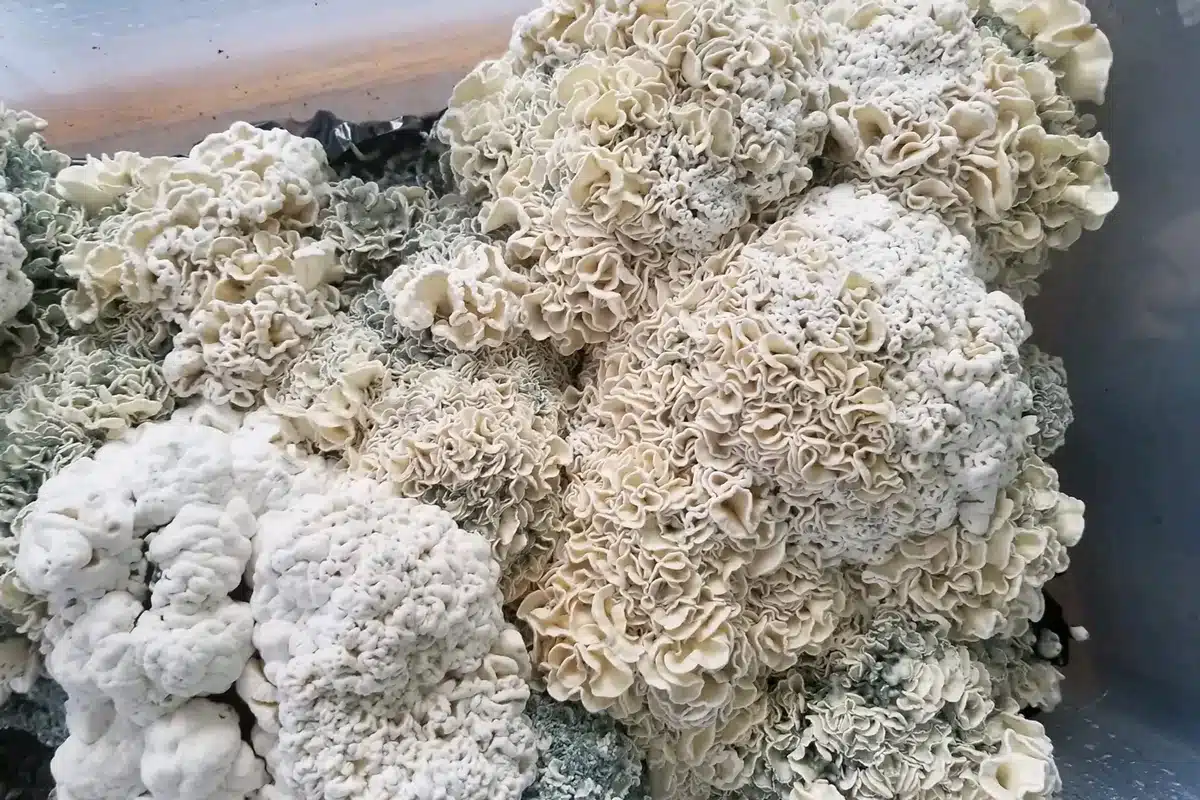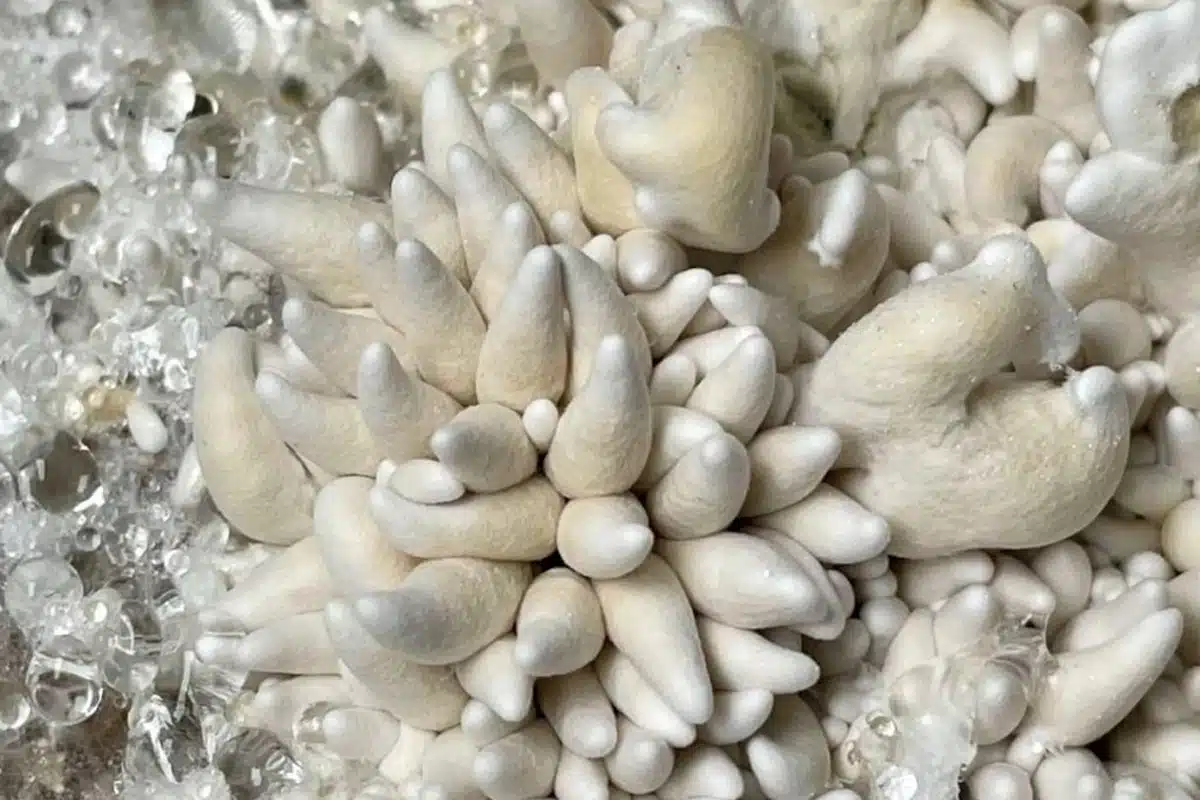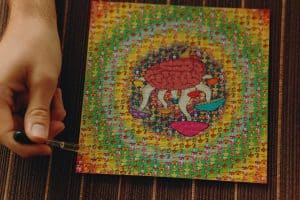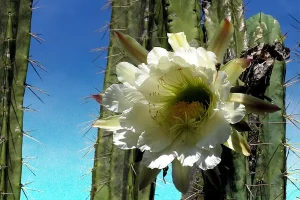It’s not uncommon to describe a psilocybin journey as mysterious, riddled with mind-expanding thoughts and deep retrospection. A more verbose traveler may call their trip an “enigma,” a word that accurately encapsulates the ineffable nature of psilocybin.
The Merriam-Webster dictionary defines the word enigma as “something hard to understand or explain.” From the appearance to the effects, the Enigma mushroom will leave those who encounter it in a daze. It looks unlike any other mushroom in the Psilocybe cubensis family and is known to pack a more powerful punch, too.
It should come as no surprise that the Enigma mushroom is one of the more mysterious types on the psilocybin scene. Its strange otherworldly appearance and reportedly potent psilocybin profile make it a rare yet well-sought-after mushroom.
What Are Enigma Mushrooms?
Enigma mushrooms, known for their unique appearance and intriguing origins, are a mutant form of the popular psychedelic P. cubensis. Their peculiar “blob mutation” leads to an unusual growth pattern, resembling dense coral or brain-like structures, which spark curiosity and discussion among mycologists and psychedelic enthusiasts.
As seen on the online mushroom communities on Reddit and Shroomery, a shroom-specific messaging board, some refer to this mushroom mutation as Tidal Wave or Brainiac.
Unlike the typical P. cubensis strain, the Enigma mushroom doesn’t fall under defined nomenclature. This funky mushroom isn’t an actual strain but the result of two cross-bred mushroom mating types, that don’t naturally reproduce together. Ian Bollinger, who co-founded Hyphae Labs with Reggie Harris, a leader in psilocybin mushroom potency testing and research space, shared his understanding of the Enigma mushroom with DoubleBlind. “Enigma is not necessarily a cultivar, so much as it is a body type or morphology,” Bollinger explained. He says that Enigma comes from Tidal Wave genetics.
The “mule of the mushroom world,” Enigma is a Frankenstein of sorts, created outside the natural ecosystem by the human hand. The mule, a cross between a horse and a donkey, is sterile. The Enigma mushroom, similarly, does not produce spores and can only be recreated through the art of cloning.
How to Grow Shrooms Bundle
Take Both of Our Courses and Save $90!
The story behind this mysterious mushroom is unknown, but some tales are passed down and shared throughout the mushroom community. What is reasonably certain, however, is that this mutated creation was born from human intervention, not in the natural environment. “The first Enigmas that were popularized were induced by causing two different mating types that would not normally mate with each other to mate,” Bollinger said.
READ: Why You Should Grow Your Own Mushrooms
In terms of what triggers the mutation, it all comes down to external factors that are likely not present in nature. This form of mutation is not unique to P. cubensis; it can also happen to non-cubensis mushroom types. We’re not talking about a specific strain but a mutation or cross-breeding of two mating types that were never meant to be.
Strain Characteristics
It’s typically difficult-to-near-impossible to distinguish types of P. cubensis by looks alone, but Enigma is a unique exception to this rule. Enigma is a “blob mutation” of the P. cubensis family, likely created by crossing two strains that would never otherwise mate. This so-called “mutation” creates a bizarre mushroom body that is alien compared to other magic mushroom types.
Enigma mushrooms often take on a blob-like form and a lumpy, brain matter-type look. This mushroom doesn’t produce a cap. It’s also unable to spread spores or make a complete fruiting body. Remember: Enigma mushrooms aren’t a unique strain but a cross between two mating types that wouldn’t cross naturally.
Harris, an experienced cultivator and the founder of Oakland Hyphae, detailed how this man-made mushroom mutation yields such a monstrous and unique harvest.
“If conditions aren’t one-hundred percent perfect above the surface, what the mushrooms will do is produce mutations of mycelium mat under the surface called sclerotia, also known as truffles,” he said. Bollinger and Harris describe this physical appearance as “surface-level sclerotia,” the lumpy component of the mushroom that typically remains underground and unseen. As this sclerotia finds its way to the surface of the substrate, it produces the brain-like curls that Enigma is known for amongst psilocybin enthusiasts. Enigma tends to grow slowly in dense clusters, often having a white or bluish hue.
Enigma Potency
Some have claimed that the potency of Enigma mushrooms tends to be higher than other strains of P. cubensis—even than the prized Penis Envy mushrooms. However, like any mushroom strain, the potency will depend on several factors, contingent on growing conditions and the external environment.
READ: Mushroom Dosage: What is the “Right” Amount of Shrooms?

We can see this wide-ranging potency of Enigma mushrooms by looking at results from the Oakland Hyphae Psilocybin Cup. The cultivator’s latest Fall 2022 Hyphae Cup Report, which includes many lab-tested mushroom strains, offers valuable insights into the specific potency of many strains, including three different Enigma mushrooms.
In the report, we found one candidate named Enigma Tony, that contained 8.4 milligrams of psilocybin per gram. According to Oakland Hyphae’s dosage chart, which helps gauge the effects of each mushroom tested, this specific strain goes from microdose to a recreational dose at the .5 gram mark, a testament to its alluring potency.
Another reported Enigma strain, dubbed Enigma B by the cultivator Bani, contained an even higher 9.3 milligrams of psilocybin per gram. The third Enigma strain showcased in the report, called Enigma Revert, was on the lower end of the spectrum, yielding just 1.8 milligrams of psilocybin per gram.
The type of mushroom strain (or mutation) is just one factor that dictates potency: there are many. The final product is very much in the hands of the grower, who should ensure that the mushrooms have consistent substrate, fresh air exchange, proper lighting, and more.
Anecdotally, many online threads are flush with comments about the comparative potency of the Enigma mutation. Regardless of potency, it’s recommended that users start with a lower dose and gradually increase it to achieve the desired effects without overwhelming the user. This guidance holds regardless of the strain, as potency varies from grow to grow, and experience varies from person to person.
Growing Enigma Mushrooms
Like other P. cubensis strains, Enigma mushrooms have specific preferences for growing conditions. Some common factors influencing their growth include substrates, growing mediums, temperature, and humidity.
According to Harris, preferred substrates for Enigma mushrooms include coconut coir and gypsum. Like other strains, these materials provide the necessary nutrients and environment for the mycelium to colonize and thrive.
Enigma mushrooms reportedly thrive in a temperature range of 75-81°F (24-27°C) during colonization and slightly lower temperatures of 70-75°F (21-24°C) during the harvesting stage. As with other strains, maintaining optimal humidity levels of 95-100 percent during the early stages of growth is crucial to success.
Interestingly, Enigma can withstand slightly colder temperatures, due to its mutated form, compared to most others in the P. cubensis family.
Harris explained the entire process typically takes about four weeks longer than the average P. cubensis strain. The Enigma mushroom’s slow nature requires some extra patience and attention. From inoculation to harvest, growers have reported that the growth process can take between six to eight weeks. One Reddit user on r/shroomers recently shared a 54-day Enigma harvest and detailed the feat as a “long ride.”
Around six to eight weeks after colonization, the lurching Enigma blobs will start to appear above the surface. One grower on Shroomery detailed the growth process for a form of Enigma, a reported genetic cross of B+ and Penis Envy, on this very active community thread.
Bollinger says growing Enigma tends to be more volatile than your tried and true cubensis. Due to its unique origins, users may see a variety of outcomes when trying to grow this mushroom culture.
How to Grow Shrooms Bundle
Take Both of Our Courses and Save $90!
“People get an enigma culture, and then they put it into their bin, and they end up with some of the blobs, and then some brown cap fruit and some white cap fruit all in the same bin,” he explained.
Like other mushrooms, Enigma is sensitive to mold and pathogens, so maintaining a clean and sterile growing environment is essential to prevent contamination.
Enigma Spores
Due to their unique mutation, Enigma mushrooms do not produce fruiting bodies or spores. Its blob-like structure is the final product, unlike your typical fruiting strain.
Enigma can only be propagated through cloning, setting them apart from others in the P. cubensis family. The only way to grow Enigma mushrooms is from a culture passed down from the original mutation, either through plated mycelium or a syringe.
For other P. cubensis strains, the spore color is usually purple-brown. In the United States, the sale of spores for microscopy purposes is legal, except in California, Idaho, and Georgia.
When searching for a reputable spore seller, looking for reliable sources with positive reviews and a history of quality products is essential; this ensures that you receive viable spores for your microscopy needs.
Enigma Mushroom: A Monstrosity or Magical Mushroom?
Enigma mushrooms are captivating additions to the world of magic mushrooms. Their unique characteristics and growth patterns have captured the attention of mycologists, growers, and psychedelic enthusiasts alike.
These mushrooms might be difficult to obtain, but Enigma is certainly easy to identify. It’s one of the few in the P. cubensis family that can be easily identified by the naked eye and offers an equally, if not more, potent experience.
Aside from the purported potency of Enigma, the awesomely odd appearance of this genetic experiment is what has made this mushroom popular amongst the shroom community. Regardless of how one might feel about these brain-like blobs, we can all agree that the Enigma is unlike anything else in its psychedelic class.
*Psilocybin mushroom cultivation is still illegal in many places. We encourage you to review and follow the laws in your region.
Interested in having a psychedelic experience, but don't know where to start? Get our definitive guide on trusted legal retreat centers, clinical trials, therapists, and more.





